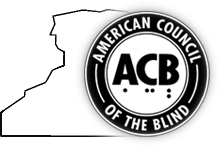The American Council of the Blind (ACB) was founded in 1961. Since its inception, ACB and its affiliates have been at the forefront of the creation of policies that have shaped the opportunities that are now available to people with disabilities in our country. ACB has also effectively collaborated with Vision Rehabilitation Service providers to develop the principles and values that should be at the heart of providing adjustment and placement services to people who are blind.
It is the responsibility of government at all levels to provide the infrastructure of services and equipment that will allow us to fully participate in our communities. This has led us to support the need for governments at all levels to provide accessible information for people who are blind.
The American Council of the Blind determined that we could have more influence over how services are delivered by working directly with service providers. As a result, we remained involved with ongoing efforts to create and implement programs that would lead to accrediting agencies who provide services to people who are blind. We have served on the boards of directors of national organizations such as National Industries for the Blind, the National Accreditation Council of Agencies Serving People Who Are Blind and the American Foundation for the Blind and we have used our influence to shape the policies those organizations have developed. Our history also includes consistently championing the provision of services to people who are blind by separate agencies who have the expertise in such areas as access technology, braille, daily living and orientation and mobility that assure that people who are blind receive the specialized services they need to be successful.
Our history has been filled with a clear and unswerving resolve to work to make it possible for people who are blind to be more independent and self-sufficient in a society whose complexity is making this increasingly difficult. When necessary, we have filed suit where appropriate, to assure that change happens but prefer to work using structured negotiations or mediation to create reform. Our efforts have led to:
- Public transit systems providing auditory stop announcements on buses and subways.
Municipalities installing Accessible Pedestrian Signals that can be used by people who are blind or deaf and blind. - States providing voting machines that allow people who are blind to vote privately and independently.
- The state of Hawaii allowing people who are blind to take their guide dogs into Hawaii without the dog being quarantined.
- Banks and other businesses providing Point of Sale (POS) credit and debit card processing devices that allow for people who are blind to conduct their business independently and privately.
In addition, we are working with leading developers of mainstream technology to assure that they understand that technology is becoming more and more visual and graphical but at the same time, must be accessible for and usable by people who are blind.
Developments of roundabouts and other traffic controls have made it more difficult for pedestrians, in general and blind pedestrians in particular, to move about freely in urban areas. The American Council of the Blind has published a state-of-the-art web-based “pedestrian safety handbook” to provide traffic engineers and people who are blind with the tools they need to develop more friendly approaches to urban planning.
Throughout our history, we have also consistently worked with other organizations on civil rights issues because we believe that there is no difference between the way that people who are blind are being treated and the way that discrimination happens for women or individuals from different racial or ethnic or religious groups.
For more information, visit our national website at www.ACB.org.

